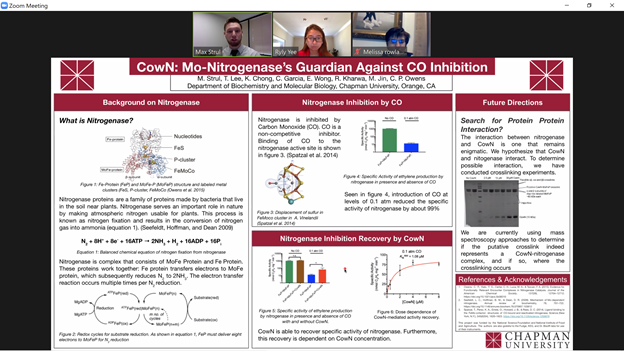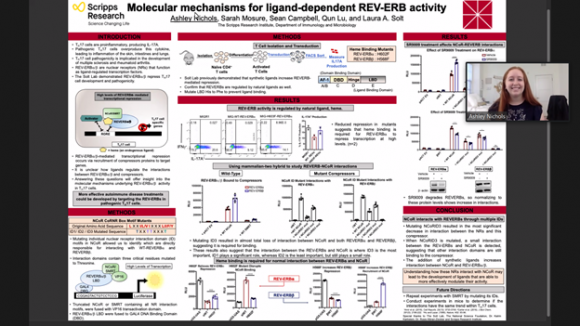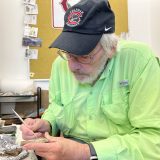
Schmid Students Share Research at Student Scholar Symposium
December 7, 2020
Last week, the Center for Undergraduate Excellence hosted the annual Student Scholar Symposium. Although this year’s symposium was virtual, more than 40 Schmid students from a variety of disciplines still participated to present their research to the Chapman community. We are so proud of all the work our Schmid students have done and can’t wait to see how they continue their ground-breaking work!
Read below to learn about some of the research our students presented at the symposium.
 Ashley Nichols – Molecular Mechanisms for Ligand-Dependent REV-ERB Activity
Ashley Nichols – Molecular Mechanisms for Ligand-Dependent REV-ERB Activity
“At Scripps Research Institute I studied how proteins called REVERBs can be utilized to prevent the development of autoimmune diseases. By studying how it functions within T cells, we may be able to target it with more effective treatment options for inflammatory autoimmune disease patients. Presenting online at the Symposium was a different experience, but I enjoyed it [and] the breakout rooms were a great way to connect with individuals who wanted to see my poster!”
Laurel Dobrow and Isabella Estrada – Effectiveness of Registered Dieticians on Adults with Type 2 Diabetes and Chronic Diseases
“The goal of our research was to examine the role registered dietitians play in the management of type 2 diabetes, particularly among the aging population. In particular, we sought to understand how engagement with a registered dietitian and interprofessional healthcare team may impact type 2 diabetes biomarkers (such as hemoglobin A1c) as well as the quality of life, and self-efficacy.
We were both nervous about presenting in a virtual setting and concerned there may be technical issues, but everyone was extremely engaged, and we really enjoyed getting to share our research with others!”
 Luke Taylor – How Effective is Hagfish Slime at Clogging?
Luke Taylor – How Effective is Hagfish Slime at Clogging?
“My research involves hagfish, which are eel-like deep-sea fishes that release thick slime when threatened. The slime has been shown to act as a defense mechanism by clogging the gills of gill-breathing predators and hindering gas exchange with water. The purpose of my research is to better understand the clogging capabilities of hagfish slime and the mechanisms behind its function.
Presenting in a virtual setting has been a unique experience that has come with unique challenges, but it has allowed me to share my research with a larger audience and forced me to adapt and improve the way I communicate science.”
Max Strul – CowN: Mo-Nitrogenase’s Guardian Against CO Inhibition
“My project was centered around a protein called Nitrogenase. Nitrogenase has the ability to reduce atmospheric nitrogen into ammonia, which is a biologically available and readily usable form of nitrogen. This protein is produced by bacteria found in the soil near the roots of plants. These bacteria have a symbiotic relationship with the plants: They provide them ammonia and in return, the plants provide the bacteria sugar. The protein Nitrogenase has a known inhibitor: Carbon monoxide. Carbon monoxide binds to the protein’s active site and actually distorts its structure, which heavily reduces its activity (In our lab we have found it can reduce its activity by up to 99%!). This being said, bacteria are able to survive in conditions with Carbon Monoxide. It was found that there is a protein called CowN that helps prevent Nitrogenase’s inhibition from Carbon Monoxide. The mechanism by which CowN protects nitrogenase from inhibition is one that remains enigmatic. Our lab has been able to produce some preliminary experimental results suggesting that these two proteins do in fact interact through Protein-Protein Interactions. Cross-linking assays and Computational modeling has provided us with some great information in our research into this interaction.
In terms of presenting virtually, nothing is quite like the butterflies you get standing at a podium in a lecture hall with a room full of people, but given the circumstances, I am beyond grateful and happy to share my research in any way possible. Presenting online does have a silver lining: It provides people a way to sign in and view the presentation from across the country. I invited my friends and family from far away, which is something I would not have been able to do otherwise. Presenting virtually is also an entirely different skillset, and I believe it is something our future students may see more and more… This is an entirely new process to navigate through, but it has been such a great experience. Moving forward, even if we could do in-person presentations tomorrow, I would recommend scientists, mathematicians, artists, and all other presenters get comfortable with this new modality of information sharing, as it can greatly increase the reach we have.”
 Sanika Pandit and Dela Hatfield – Designed Hydrogel Microspheres for Management of Thrombosis
Sanika Pandit and Dela Hatfield – Designed Hydrogel Microspheres for Management of Thrombosis
“Our project focused on the management of thrombosis by forming and breaking down blood clots. We used microgels as a way to either initiate or prevent clotting. The super-resolution mode of the confocal microscope was leveraged to allow us to better understand how simple polymer particles can recapitulate complex biological functions, such as clot formations and clot breakdown.
I thought the symposium was a lot of fun. It was a great way to end such an interesting semester since Dela and I had both put a lot of work into our research. I really enjoyed presenting and talking about the work that I had spent so much time on with faculty that I can’t always see because of COVID.”

